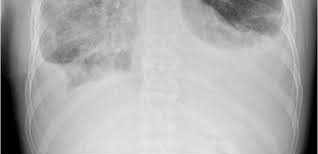Lymphangiomatosis is a condition in which the lymphatic system develops a large number of tumors (lymphangiomas) or cysts. In this disease, It is possible to develop tumors that are not malignant but that invade the body’s tissues and cause symptoms such as discomfort, difficulty breathing, and more. Lymphangiomas are benign tumors that develop in the connective tissue, organs of the body, or bones. As they grow, they can block, compress, or kill the surrounding tissues.
Lymphangiomatosis is a mild lymphatic vessel overgrowth. Lymphangiomatosis is a medical term that refers to a tumor or cyst in a lymphatic vessel.
It is believed that lymphangiomatosis, along with other lymphatic abnormalities, is caused by defects in lymphatic development that occur during the first 20 weeks of a fetus’s development. Lymphangiomatosis is characterized by cysts caused by abnormally linked and dilated thin-walled lymphatic channels. This disorder is particularly prevalent in the lungs and bones of the body. For the best diagnosis and symptom management, a multidisciplinary approach is usually required.
Lymphangiomatosis Symptoms
Lymphangiomatosis, like angiomatosis, primarily affects children and only appears after the age of 20. The diagnosis at birth is rare since many abnormalities require a latent time to become evident. There is no preference based on gender. The symptoms vary depending on where the infection is and how bad it is. Multiple bone lesions impact more than three-quarters of patients. “Fibrous dysplasia” or bone alterations linked to hyperparathyroidism are common diagnoses for these well-defined osteolytic lesions with varying sclerosis.
Some of the earliest symptoms of sickness in the chest are wheezing, coughing, and a sense of being short of breath; however, these symptoms are frequently misinterpreted as asthma. In younger children, the discomfort that is associated with skeletal involvement is linked to what is known as “growing pains.” With bone involvement, a pathological fracture is the initial sign of illness. Symptoms are not noticed until the disease becomes advanced and compressed vital structures.
When the condition affects the kidneys, it causes symptoms such as flank discomfort, abdominal discomfort, blood in the urine, and possibly raised blood pressure, which is often mistaken for other cystic renal diseases. Lymphangiomatosis that affects the spleen or liver is mistaken for polycystic liver problems. Some of the symptoms of Lymphangiomatosis affecting kidneys are:
- Weariness.
- Weight loss.
- Disseminated intravascular coagulopathy.
- Anemia.
- Accumulation of fluid in the stomach.
Lymphangiomatosis Life Expectancy
Lymphangiomatosis is a disease that affects multiple organ systems. The life expectancy of lymphangiomatosis patients varies depending on the parts of the body or body systems affected by the disease.
Patients with diffuse pulmonary lymphangiomatosis (also known as pulmonary lymphangiomatosis) own a dismal prognosis; there are currently no targeted treatments for this disease, therefore treatment focuses on managing symptoms as best as possible. The major factors that cause death are problems with breathing, infections, and a buildup of chylous fluid.
Lymphangiomatosis Diagnosis
Lymphangiomatosis is difficult to diagnose since it is unusual and possesses a vast range of imaging, clinical, and histological characteristics. Plain x-rays are enough to show lytic tumors in chylous effusions, bones, pathological fractures, and interstitial infiltrates in the lungs, even if no indications are evident.
Many lymphangiomas are seen in the body, which helps to confirm a diagnosis of lymphangiomatosis. An examination of a tissue sample, often known as a biopsy, is performed mostly to help verify that the lesions are lymphangiomas. Some other diagnostic techniques that are mostly used are as follows:
- Lung function tests.
- Pulse oximetry.
- VEGF-D blood test.
- CT scan or MRI of the abdomen.
- Lung biopsy.
Lymphangiomatosis Treatment
Lymphangiomatosis has no known cure, however, there is currently an effective treatment to keep the disease stable and prevent it from worsening (getting worse). Patients who demonstrate symptoms of lung function damage as a consequence of Lymphangiomatosis are given the medicine sirolimus. This medicine is also be used to treat big kidney angiomyolipomas. Everolimus is a drug from the same class that is used to treat this illness in some circumstances. For the treatment of people with diffuse pulmonary lymphangiomatosis, several medicines are documented in the scientific literature. The two most commonly used medicines for this disease are glucocorticoids and Interferon alfa 2b. Some other drugs that are utilized in this case include; rapamycin, thalidomide, and bisphosphates.
Some therapies that are employed in certain circumstances are:
- The use of oxygen as a treatment.
- Inhaled drugs that aid in the improvement of lung airflow.
- Procedures to drain chest fluid or diminish angiomyolipomas.
- Lungs Transplant
 Health & Care Information
Health & Care Information 


